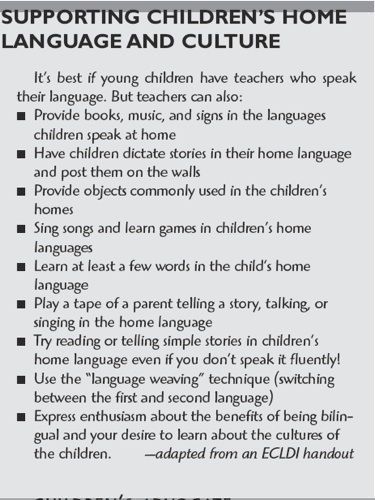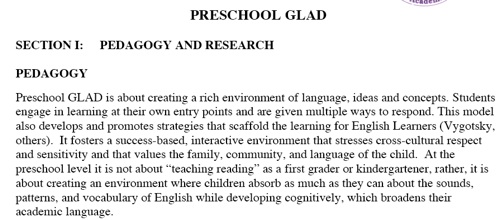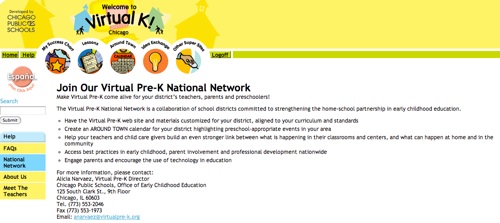The program develops a strong foundation in the home language with exposure to oral English language development. While students learn the social language necessary to communicate with others, they also learn the language of literacy, thinking, math and science through developmentally appropriate activities. A wide variety of activities provide children with opportunities to explore, imagine, and create. High quality multicultural and bilingual resources are included, and teachers use practices that help children understand the language of interactions and the concepts being communicated.
How are the learning opportunities for preschool DLL and other students different from learning opportunities for kindergarten ELLs?
Preschool learning opportunities center around children’s interests in, and exploration of, the learning experiences and resources provided. These should include interest centers, small and gross motor activities, an available science display table, art and music opportunities, quality children’s literature in the home language, counting and sorting activities built into the everyday program, language-rich daily interactions in their home language with exposure to English, and guidance in socialization. This represents a child-driven curriculum, focused upon providing intriguing materials and activities for children to explore, according to their individual interests.
Kindergarten learning opportunities are focused upon instruction to support attainment of the California State Standards for that grade level, which are aligned with K-12 standards and curriculum. Standards address learning goals including Reading/English Language Arts, Mathematics, Health, Social Science, Science, Physical Education, and Visual/Performing Arts.
This means that preschool children are exposed to a broader and richer curriculum that is developmentally appropriate; it includes preliteracy and numeracy, but also provides children a greater opportunity to develop their two languages, talk to each other, explore, create and imagine. The curriculum should also include plenty of music experiences and physical activities.
“School readiness is a back-mapping concept that starts by defining what children should know and do in kindergarten and first grade, then asks, ‘how do we get them there?’ In high quality early childhood education programs, the answer is through the integrated development of several domains: the physical/motor, social/emotional, cognitive and linguistic. From an early childhood education perspective, young children are best prepared for later academic success through an experience-rich environment in which they develop language through tangible experiences. They learn to ‘name’ their world, to think and speak about their experiences: playing, building, drawing. They learn to interact with their teacher when they eat, put on their sweaters, and take off shoes. They learn scientific concepts and measurement while dividing up snacks or building blocks. They begin to view writing as a form of communication during story time. Most learning theorists agree that this type of holistic, relationship-based, integrated experience is the basis for abstract thought. This is the high quality early childhood education, which many see as the strongest possible preparation for achieving in school.”
(Ready or Not? p. 14)
Marta Suarez, Program Director:
“I’m concerned about the academic agenda for early childhood education. It’s a view of 8- to 12-year olds being applied to young ones, an academic view of learning that isn’t appropriate for early childhood. Yes, we have to prepare them, we DO prepare them for school, but it’s learning that’s about exploring and communicating and being read to. Not the narrow emphasis on pre-reading as tracing letters! Not flash cards and rote memorization! Not making 2- and 3-year-olds sit in a circle time for 45 minutes! Is it necessary that they accomplish ‘x, y and z’ on a fixed timetable? What about the 3-year-old-kid who isn’t interested in tracing letters or sitting still in a circle but goes to the sandbox and can be focused for half an hour, fascinated by bugs? That’s learning. That’s focus and concentration!”
(From Ready or Not?, p. 15)
What is the best curriculum to use with DLLs in preschool?
PROMISE Preschool does not advocate a particular curriculum for use with preschool children. However, adhering to the PROMISE Preschool core principles, especially around an enriched and affirming learning environment, would be particularly important. More specifically, there are a number of curriculum components that are appropriate for young DLL children.
Regardless of the curriculum selected, supplemental materials and activities will need to be integrated to meet all the needs of the students.
What are the best instructional practices to use when serving young children in preschool?
I’ve heard that we should encourage children to interact with each other, but how can we encourage dual language students to interact with their peers, especially if their peers are English speakers?
It is important to get children to practice language as much as possible. Finding ways to help them use language in groups, pairs, triads, and even “rehearsing to themselves” can be beneficial. However, we cannot just assume that young children will know how to practice language in meaningful ways. We need plan and set up meaningful opportunities for them to talk with peers and practice using more and varied vocabulary and grammatical forms in each language, as well as the English phonemes that differ between Spanish and English.
How can I know if my curriculum is effective for Dual Language Learners? What should I look for?
The PROMISE Preschool Curriculum Review Tool is very helpful for determining whether a curriculum is effective for your DLL students. It provides some helpful guidelines about what to look for and how to evaluate major features of a curriculum. See “Additional Research and Resources” for the downloadable PROMISE Preschool Tool.
What if my school/district has already purchased a curriculum and this tool shows it is not as effective as it could be for Dual Language Learners and we have no more money to purchase other curriculum? What should I do?
You can use the current curriculum but realize that you will need to analyze, adjust, or make some changes to it.
“Many culturally competent programs build a child’s culture into the curriculum by bringing parents and community members into the classroom as teachers, using the home language, having parents bring artifacts from hoe, and ensuring that books and posters reflect the child’s home culture. Such programs actively invite close relationships with families, engage in frequent two-way dialogue, and seek to make the school and family environments as seamless and compatible as possible.”
(Ready or Not?, p. 17)

What is the best model to use with Dual Language Learners in Preschool?
Based on the research on the education of DLL students and young bilingual children, PROMISE recommends three models for the education of DLL preschoolers:
In all three models, parents are encouraged to speak and read to their children in the home language.
Recent reviews of research conclude that dual language children may be more successful in learning to read when they are instructed in both their home language and English. In a recent study by Claude Goldenberg, he reported that “Teaching students to read in their first language promotes higher levels of reading achievement in English.”
What kinds of training should I provide for my teachers who work with dual language preschoolers?
There are several types of knowledge about curriculum, instruction, assessment and family engagement that would help teachers be more effective with dual language children. These include:
PRESCHOOL GLAD – AVAILABLE IN ENGLISH & SPANISH

Beginning with a large sheet of butcher paper, Pre-K GLAD offers customized vocabulary, drawings specific to current themes and interests, and children’s own language, instead of a structured, pre-designed curriculum. Teachers might present an Observation Chart, using a language experience narrative; an Inquiry Chart, employing K-W-L categories; Pictorial Input, in which children bring a drawing or cut-out picture to the chart for comparisons; or any one of other numerous options. Teachers and/or children draw on the butcher paper as children observe, and write targeted vocabulary within a context. This might include a narrative, chant, poem, or song, presented by the teacher or contributed by the children. The lesson might evolve over several days, and remains on display for children to review and read.
Although the lesson content is provided by the teacher, based upon relevant themes and children’s interests, the Unit Planning format supports development of integrated curriculum and incorporation of individual lessons.
Planning for Pre-K GLAD lessons follows an Idea Page graphic organizer, to address:
Contacts for Pre-K GLAD include Christie Baird, Preschool GLAD Director, Orange County Department of Education: cbaird@ocde.us or 714-327-1078, and Cathy Wietstock, Manager, Early Childhood Education, cwietstock@ocde.us or 714-327-1078.
Virtual Pre-K: https://www.virtualpre-k.org/home
